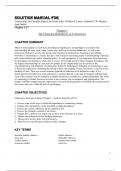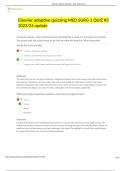Solution Manual For
Criminology 3th Canadian Edition By Freda Adler, William S. Laufer, Gerhard O. W. Mueller,
Jana Grekul
Chapter 1-13
Chapter 1
The Changing Boundaries of Criminology
CHAPTER SUMMARY
Much of what happens on earth has criminological significance. Criminology is concerned with
understanding the who, what, when, where, why, and how of criminal behaviours, as well as the
behaviours of those in society who decide what should be considered law-breaking or law-abiding
behaviour. Criminology is a science that has a role to play in increasing people‘s understanding of deviant
and criminal behaviours and in informing policy. As such perspective is very important when discussing
the boundaries that determine what crime is or isn‘t, how people perceive these changing boundaries, and
the impact understandings of crime have on people. In this chapter there is a discussion of the
conceptualization and definition of criminology. Edwin H. Sutherland‘s definition of criminology is used
to frame the explanation, including the making of laws, the breaking of laws, and society‘s reaction to the
breaking of laws. There are several elements required for behaviour to be defined as crime. If it is
determined that the behaviour of an individual is criminal, then he or she may be charged with that crime.
Each of the elements may be refuted by a number of defences available to a criminal defendant. The reach
of criminology is further discussed in terms of the economy, the environment, and globalization. The
chapter concludes emphasizing the importance of research informing policy and briefly discussing some of
the careers that exist within the field of criminology.
CHAPTER OBJECTIVES
Following a thorough reading of Chapter 1, students should be able to:
1. Discuss some of the ways in which the boundaries of criminology change.
2. Explain why criminology can be described as multi-disciplinary.
3. Discuss the various influences on the creation of law.
4. Discuss the elements common to all crimes.
5. Explain how a defence can negate one or more of the elements of a crime.
6. Outline the influences on law-breaking behaviour.
7. Discuss how society deals with lawbreakers.
8. Describe how criminologists influence policy changes.
KEY TERMS
absolute-liability offences hybrid offences
actus reus indictable offences
conflict model interactionist model
consensus model mens rea
1
,crime moral entrepreneurs
criminal justice system social norms
criminologists strict-liability offences
criminology summary offences
deviance
CHAPTER OUTLINE
I. The Changing Boundaries of Criminology
A. The Importance of Perspective
1. Perspective matters and influences our understanding of events we call criminal.
2. Perspectives of individuals vary and change, as does the perspective of the state when laws
change over time.
B. Why Do Perspectives and Boundaries Change?
1. Our definitions of criminal behaviours change because crime is closely connected to notions of
morality.
C. Moral Entrepreneurs and Context
1. In a democratic society like Canada, interest groups can and do play a significant role in the
definitions, normative and legal, of appropriate behaviours.
2. Moral entrepreneurs are people who are passionate about a cause and who use their political,
economic, or educational influence to raise awareness about an issue and who work toward
making changes in laws.
D. Media
1. Media shapes public and private understandings and perceptions of criminal events.
2. Media can distort the truth, presenting a particular version of the story, usually the version that
will sell the most newspapers.
E. Public Opinion
1. The public is influenced by the media and as a result can influence the actions of politicians.
2. The public can also influence definitions of criminal behaviours through frequency of behaviour,
as well as through education and awareness.
F. Consequences of Boundary Changes
1. Changes in definitions of what is legal or illegal have consequences for criminologists but also
for people‘s lives.
2. For example the creation of a separate youth justice system in 1908 had implications for the
treatment of youth who broke the law, their families, and society in general.
II. What is Criminology?
A. Coining of the term ―criminology‖
1. First used by Raffaele Garofalo in 1885.
2. Paul Topinard next used the term in 1887.
B. Edwin H. Sutherland‘s definition of criminology is widely accepted.
2
, 1. Sutherland defines criminology as ―the body of knowledge regarding crime as a social
phenomenon. It includes within its scope the process of making laws, of breaking laws, and of
reacting toward the breaking of laws. The objective in criminology is the development of a
body of general and verified principles and of other types of knowledge regarding this process
of law, crime, and treatment or prevention.‖
2. Sutherland‘s definition mandates that criminologists collect information for study and analysis in
accordance with the research methods of modern science.
C. Criminology is multidisciplinary.
D. Canadian criminologists are faced with a number of factors that make Canada unique and that
therefore influence their work.
III. The Making of Laws
A. Deviance
1. The term deviance is used to describe behaviour that violates social norms.
2. Objective views of deviance claim that the presence of certain characteristics defines deviance
while subjective views of deviance claim there is no shared trait or characteristic that defines
deviance.
3. A subjective approach to understanding deviance means focusing on the social construction of
deviance and the recognition that deviance and conformity are in a constant state of flux.
4. The difference between crime and other forms of deviance varies by geography and time.
B. The Concept of Crime
1. Crime is any human conduct that violates a criminal law and is subject to punishment.
2. The Babylonian Code of Hammurabi and the Roman Law of the Twelve Tables do not list
homicide or ordinary theft as crimes.
3. All early societies imposed punishment for behaviour that was detrimental to their own
existence, for example, treason.
C. The Consensus, Conflict, and Interactionist Views of Law and Crime
1. The consensus model suggests that some behaviour is deemed so threatening to society‘s
survival that they are designated as crimes.
a. This model assumes that members of a society by and large agree on distinctions between
right and wrong.
b. Adherents of this model believe that laws function to reconcile and to harmonize most of the
interests that most of society accepts, with the least amount of sacrifice.
2. The conflict model suggests that the criminal law expresses the values of the ruling class in a
society, and the criminal justice system is a means of controlling the classes that have no power.
3. The interactionist model is similar to the conflict model in that the focus is on interest groups
vying for power and influence over law-defining, law-making and law-enforcing processes. It is
different from the conflict model in that it allows for a wider variety of interest groups involved
in these conflicts (rather than focusing solely on the ruling class).
IV. The Legal Ingredients of a Crime
A. Actus Reus
1. Law scholars have long agreed that one fundamental ingredient of every crime is a voluntary
human act.
a. The law is interested only in an act (actus) that is guilty, evil, and prohibited (reus).
2. The criminal law, in principle, does not penalize anyone for a status or condition.
3
, 3. Inaction may be action when the law clearly spells out what one has to do and one decides not
to do it.
a. The law in Canada imposes no duty to be a Good Samaritan; the law requires action only is
one has a legal duty to act (e.g. lifeguards are contractually obligated to save swimmers from
drowning).
B. Mens Rea: The ―Guilty Mind‖ Requirement
1. To be convicted of a criminal offence, it must be proven that the accused carried out the act
intentionally, knowingly, and willingly.
a. For some crimes, less than a definite intention suffices: reckless actions by which the actors
consciously risk causing a prohibited harm.
2. For absolute-liability offences, the fact that the actor makes an innocent mistake does not affect
criminal liability; strict liability refers to a class of offences for which legislatures or courts are
not required to prove criminal intent or mens rea.
C. The Concurrence Requirement
1. The criminal act must be accompanied by an equally criminal mind in order for a criminal act
to occur in the legal sense.
D. Indictable and Summary Offences
1. There are two main categories of criminal offences distinguished by the procedure for dealing
with the accused and the penalty dispensed to the convicted.
a. Summary offences (e.g. loitering) are considered more minor; cases are heard in
provincial or territorial courts and they can result in a fine of up to $5000, a sentence of up to
two years less a day, or both.
b. Indictable offences involve a trial by judge or judge and jury, depending on what the
defendant chooses, a much more serious punishment; there is no limitation period on
prosecution for these crimes.
c. Hybrid offences can be tried summarily or by indictment, depending on the discretion of the
Crown.
V. The Defences
A. The number of convictions is substantially smaller than the number of crimes reported and the
number of crimes prosecuted.
B. Not all elements of the crimes charged can be proven in court.
C. Each defence negates one or more of the elements of the offence charged.
1. Insanity defence (Not Criminally Responsible)
2. Defence of the mistake of fact
3. Self-defence
4. Duress
5. Provocation
6. Intoxication
7. Automatism
VI. The Breaking of Laws
A. There is no agreement as to why some people are prone to commit crime and others are not. There
are a variety of perspectives that seek to address this question.
1. Biological perspective
4






